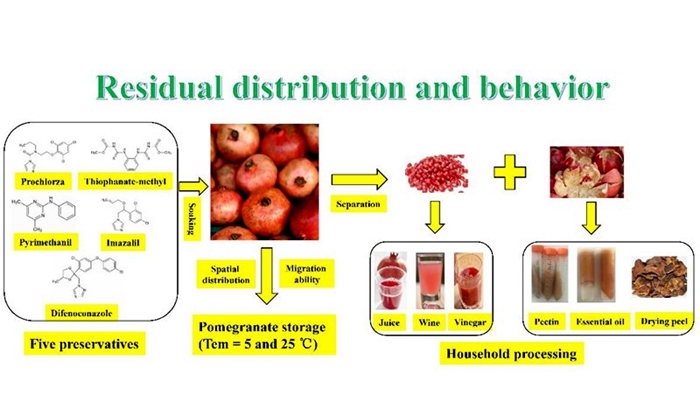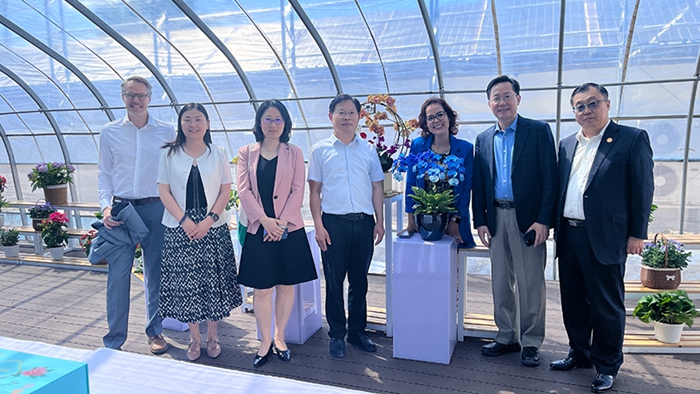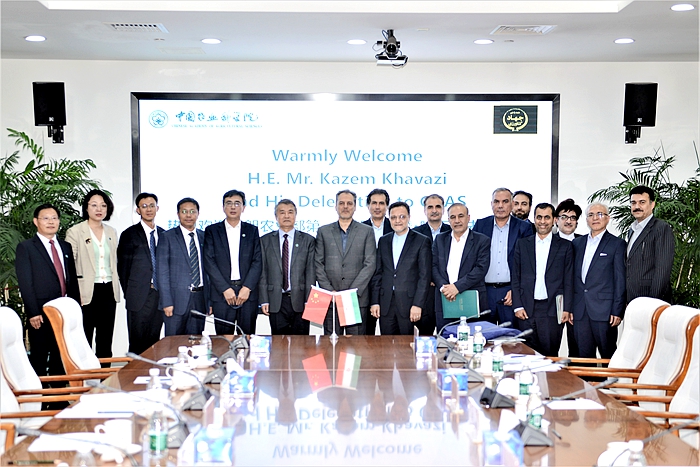Effects of storage and processing on the residual distribution and behavior of five preservatives and their metabolites in pomegranate
China is the main producer of pomegranates in the world, with its output ranking among the top in the world. Pomegranate is not only consumed fresh, but also processed into a variety of edible consumer products, such as juice, wine, jam, spice (anardana), and even food supplements. Approximately three million tons of pomegranates worldwide are processed into products such as juice (the main product), vinegar, and wine every year. And the amount of antioxidants in pomegranate juice is the highest among all foods. Pomegranate peel accounts for approximately half of the whole fruit weight and contains a high level of phenolic acids, tannins, and flavonoids. Pomegranate peels were often processed into various products including pectin, dried peel, and essential oils. Pomegranate is vulnerable to diseases during storage. Pomegranate fruit rot is a common and most serious disease during the production, transportation and storage, causing serious losses to the pomegranate industry chain. At present, the use of fungicides for pomegranate preservation remains one of the most conventional and economical means to control the disease during storage. Due to environmental conditions such as heavy rainfall, strong sunlight, and high temperatures, the half-lives of most pesticides in the field is relatively short. The environmental conditions during storage are low temperature and darkness. The ultimate result is a significant extension of the half-lives of pesticides. Hence, the pesticide residues may pose potential threats to human health during pomegranate storage. In addition, the processing operations can affect the pesticide residues, leading to an increase or decrease in pesticide residues, and even promoting the production of highly toxic metabolites. So far, the pesticide residues in grapes and their processed products have been well studied. However, there are no studies on the changes of pesticide preservatives and their metabolites during pomegranate storage and processing. Hence, it is important to monitor the quality and safety in pomegranate and its processed products.
In this study, the detailed description of the behavior of prochloraz, thiophanate-methyl, pyrimethanil, imazalil, and difenoconazole, and their metabolites during pomegranate storage and processing. QuEChERS extraction procedure and HPLC-MS/MS were established and validated for determining five preservatives and their metabolites in the samples of pomegranates and their processed products. The spatial distribution of the five preservatives and their metabolites was consistent, with the highest residual amounts in the calyx, followed by peel, stalk, umbilicus, and septum, and lowest in seed. During storage, the results suggested that the residual amounts of the metabolites of five preservatives (expect for the metabolite of difenoconazole, which was not detected) progressively increased in the calyx, peel, and stalk, indicating that the degradation of five preservatives in these tissues mainly involved metabolism and migration. In addition, the distribution concentration of five preservatives in pomegranate correlated positively with Log Kow of the pesticides. Nevertheless, for the migration ability, the five preservatives from pomegranate peel to seed was negatively correlated with Log Kow. The residual amounts of the five preservatives and their metabolites in seed ranged from <0.001 mg kg-1 to 0.83±0.12 mg kg-1 during the whole storage period at different temperatures. The concentrations of these compounds were obviously lower than the MRLs established by China. The processing factors of each procedure of juice, wine, vinegar, pectin processing were less than 1. Nevertheless, the PF values in drying peel during the overall process ranged from 1.26 to 4.09. The essential oil extracted from pomegranate peel and pomegranate drying peel posed potential health risks to consumers. The systematic description of the spatial distribution, migration of five preservatives their metabolites during pomegranate storage and the metabolism of five preservatives can deepen our understanding of the safety of pomegranate from postharvest to storage and processing. To sum up, the results contribute to the rational use of preservatives in pomegranate storage and to reduce pesticide residues in the household processing. The results have been published in the Food Chemisry (IF: 8.8).
This study was finished by Prof. Hanzhong Xie’s lab from Zhengzhou Fruit Research Institute, CAAS. The first author and corresponding author are Dr. Fajun Tian and Prof. Hanzhong Xie, respectively. This work was supported by the National Natural Science Foundation of China (32202347), the Agricultural Science and Technology Innovation Program (Grant CAAS-ASTIP-2019-ZFRI-09), Central Public-interest Scientific Institution Basal Research Fund (No.1610192023106) and the quality and safety risk assessment for agro-products of China (Grant GJFP20220202).
The URL for this article should be:
https://www.sciencedirect.com/science/article/pii/S0308814624015553

By Tian Fajun
tianfajun@caas.cn
-
 Jun 18, 2024Visit by CGIAR Executive Director Ismahane Elouafi to the Institute of Vegetables and Flowers,CAAS
Jun 18, 2024Visit by CGIAR Executive Director Ismahane Elouafi to the Institute of Vegetables and Flowers,CAAS -
 May 29, 2024CAAS President Meets Deputy Director General of IAEA
May 29, 2024CAAS President Meets Deputy Director General of IAEA -
 May 29, 2024CAAS President Meets Chairman of the Understanding China Forum
May 29, 2024CAAS President Meets Chairman of the Understanding China Forum -
 May 29, 2024CAAS President Meets Greek Minister
May 29, 2024CAAS President Meets Greek Minister -
 May 29, 2024CAAS President Meets Iranian First Deputy Minister of Agriculture
May 29, 2024CAAS President Meets Iranian First Deputy Minister of Agriculture
